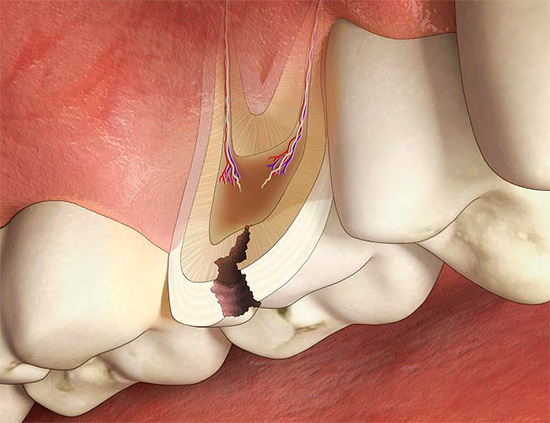
Questions about the causes, intensity and duration of pain during and after the treatment of caries are perhaps one of the first places among the popular questions to the dentist-therapist. Treatment of deep caries is generally the most difficult manipulation among the treatment of other carious lesions, therefore, unfortunately, it is not always without pain here.
According to the classification of the depth of the carious process, the following types of caries are distinguished:
- Elementary;
- Surface;
- Average;
- Deep.
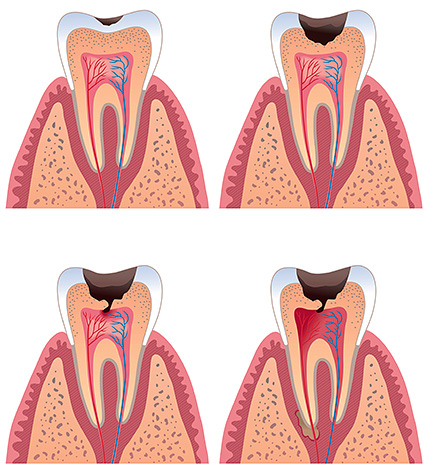
The last stage of the development of the carious process involves the proximity of damaged and infected tooth tissues to a healthy pulp (“nerve”). As a result of this, there is always a risk of confusion between deep caries and the onset of complications in the pulp of a tooth when a carious infection enters it. Therefore, in such cases, treatment should be carried out only after a detailed diagnosis of the stage of the process.
The factors of the appearance of deep caries
The causes of caries in general, including deep, are directly related to the activity of cariogenic microorganisms in the oral cavity. During the fermentation of carbohydrates, bacteria of the Streptococcus mutans species (and some others) produce organic acids that cause the initial forms of enamel destruction (caries spots) to occur with a gradual transition of the pathological process to dentin tissue.
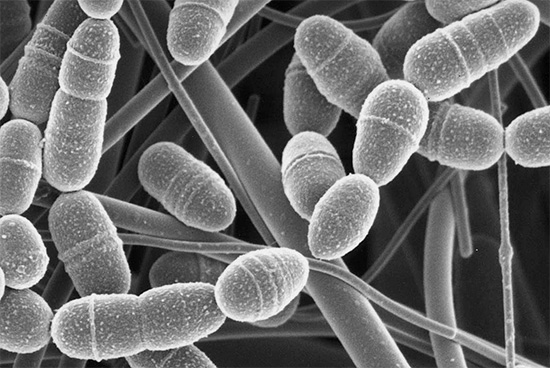
In this case, dentine softens due to the release of mineral components (calcium, phosphorus, fluorine compounds) from it, followed by dissolution of organic matter (collagen) under the action of bacterial enzymes. The formation of a cavity as a medium caries with softened infected dentin, without treatment, inevitably leads to a deepening of the pathological process and an increase in the area of destruction. If at this stage you do not treat deep caries, you can lose time and there will be a complication with the transition of the infection into unprotected pulp tissue (“nerve”) inside the tooth.
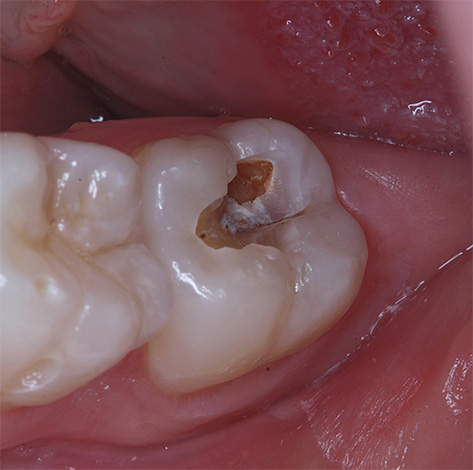
Unfortunately, not everything depends on the person himself. There is another important factor that some people encounter when dealing with a problem tooth: the secondary occurrence of caries under a filling in case of various violations in it or under it. If some stages of the treatment of deep caries for various reasons were performed with an error, then deep caries occurs under the seal. This is especially true for defects and chips of poorly placed seals.
On a note
Unfair treatment of deep caries by a dentist is usually associated with the following factors:
- With a poorly cleaned carious cavity from infected and softened dentin, when the filling cannot elementarily stay on the soft tissues of the tooth.
- With poor isolation of the working area from saliva, gingival fluid and blood. Often, during work, the necessary means of isolation and preparation for filling are not used, and most of the materials for fillings, as you know, are not firmly fixed in a humid environment. With long-term results, this leads to loss of all or part of the seal, spalling, cracks, violations of the marginal fit, etc. In any case, the process of tooth decay often continues after such treatment.
- In violation of the instructions for the selected filling material or with the wrong choice of material in a particular clinical situation. Due to the variety of modern fillings, errors are possible at the stage of setting the material, often associated with the doctor’s time limit. Any trifle for modern "light" fillings is especially important and determines their guarantee and durability.
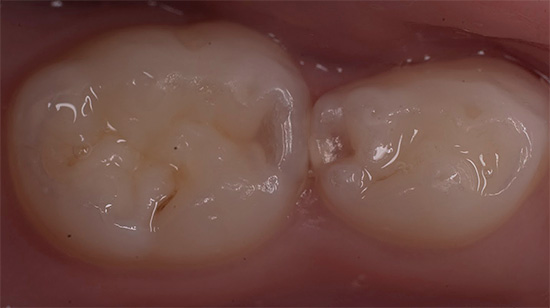
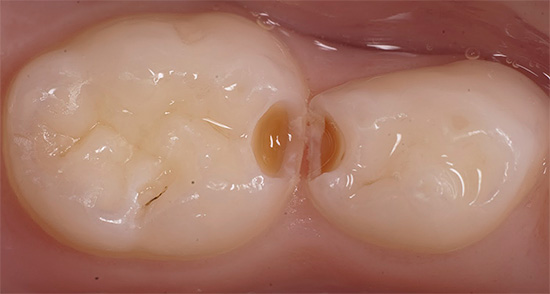
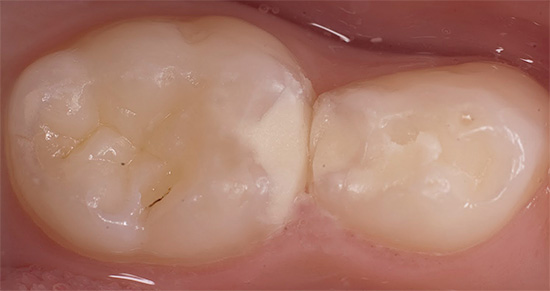
Localization of cavities in deep caries
Today, for the convenience of treating deep caries, doctors use Black's classification of carious cavities, depending on their location on the chewing and front teeth.
Class I. Localization of the carious process in places of natural fossae and fissures of small, large molars and incisors.
Class II Localization of lesions on the contact (lateral) surfaces of molars and premolars (large and small molars).
Class III The location of the cavity on the contact (side) surfaces of the canines and incisors while maintaining the cutting edge and corners of the crowns.
Class IV The location of the carious process on the contact (side) surfaces of the canines and incisors with a violation of the cutting edge and corners of the crowns.
Class V. Localization of carious lesions in the neck of all groups of teeth.
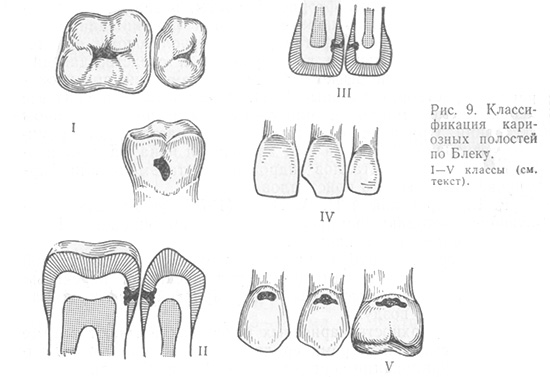
It is interesting
The classification of cavities was introduced by Black in 1896 to standardize methods for the preparation and filling of cavities and exist to this day. However, modern “light-cured” materials, the basis of which is based on the principle of “chemical bonds” with tooth tissues, allow us not to adhere to the rules and techniques of preparation according to Black. Despite this, dentists are actively using it in various clinical situations in order to properly treat deep caries.
It is also noteworthy that after the death of the author another 6th grade was added, which they began to officially name "according to Black." It includes cavities on the cutting edges of incisors and fangs and tubercles of molars. Most dentists are of the opinion that this class was erroneously added to the main classification, since the author did not give consent to this.
The main symptoms of deep caries
Before treating deep caries, the dentist carefully examines the patient’s complaints, since at this stage it is already possible to confirm or deny the diagnosis.
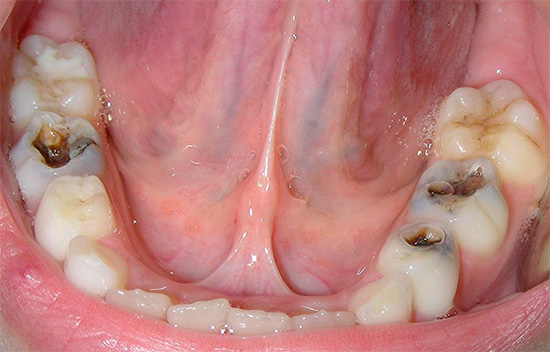
If we collect statistics from case histories of deep caries, then among the most common complaints and their features, the following can be distinguished:
- Aesthetic imperfection or deformation of the tooth.
- Pain from temperature irritants (hot and cold), chemical (mostly sweet) and mechanical (when solid food enters the cavity).
- Short-term nature of the pain. The pain quickly disappears after elimination of the irritant.
- Violation of the filling (spalling, displacement, loss) and related caries, proceeding either asymptomatically, or with the aforementioned short-term pain syndrome, when the tooth periodically aches.
Criteria for the choice of filling material before treatment
After diagnosis, treatment of deep caries is carried out according to the accepted protocol. Before the preparation (treatment) of the carious cavity, the dentist determines in advance the approximate set of filling materials needed in this clinical situation.
Now let's talk about which basic materials, and in which case are preferred.
An outdated type of filling materials is amalgams (silver and copper). They can not be used in front teeth, since they are not aesthetic, so the area of their use is Black classes 1, 2 and 5, as well as for teeth covered with crowns.
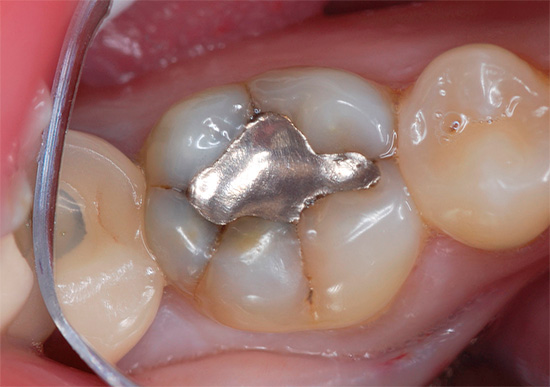
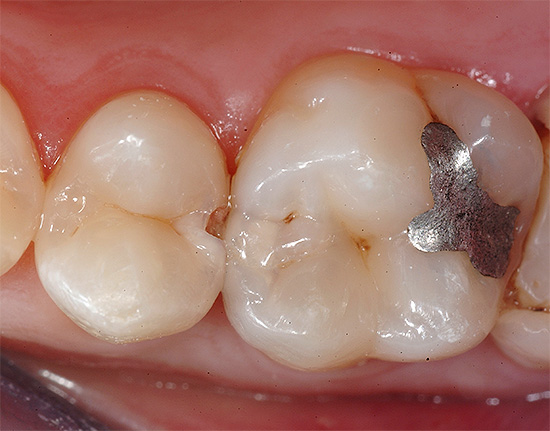
It is interesting
For the treatment of deep caries in the XX century, amalgams were an indispensable filling material that is still found. Virtually no fillings except amalgam, which boasts a 20-30-year safe existence in the tooth. Silver amalgam is a metal seal with an active antibacterial effect of silver (and mercury). The possibilities of its retention are almost endless.
Unfortunately, in Russia it was hastily canceled due to the likelihood of infection of the body with mercury, since silver powder was kneaded on it.American dentists have successfully proved the opposite: they carried out a number of studies and did not identify the possibility of mercury poisoning even for personnel, while observing conservation standards. According to the latest data, since 2000, American dentists have been annually staging an amalgam for several million teeth. In Russia, amalgam is almost never used, although the treatment of deep caries with their use is quite effective.
A more modern type of filling materials is the so-called glass ionomer cements (SIC). Most often, SIC is used in the treatment of deep caries as a lining material for fillings or restorations from composites, almost all Black classes (it all depends on the material grade), for filling all classes of milk teeth, sealing fissures, fixing crowns, etc.
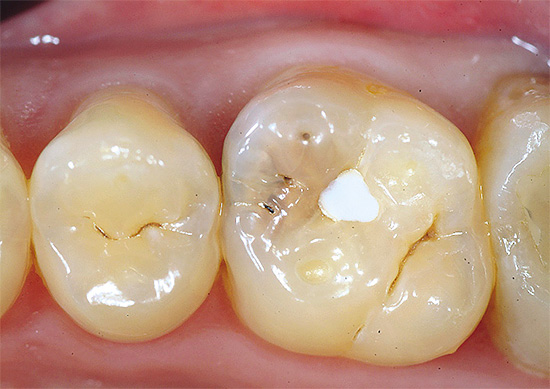
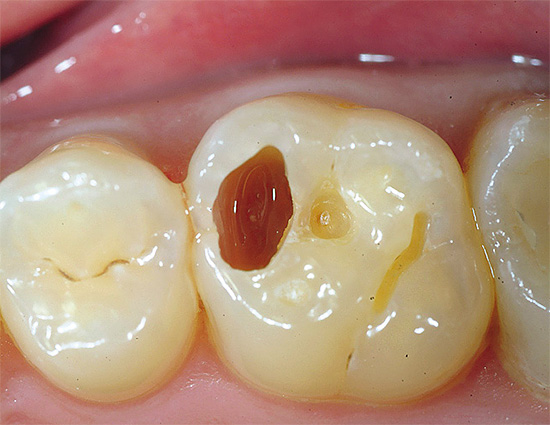
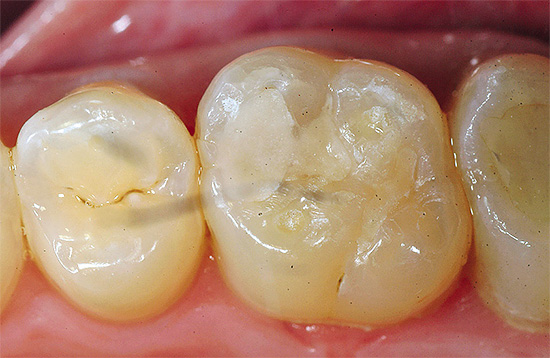
The doctor may give preference to this material in the following cases:
- terrible oral hygiene;
- multiple caries on the teeth;
- the location of the carious cavity below the level of the gum (under the gum);
- the impossibility of isolating the working area from moisture.
Another type of seal materials is composites. We will not dwell in detail on their types, we only note that there are composites of chemical and light curing.
Modern clinics give preference to functional and aesthetic light-curing materials that have proven themselves in the treatment of deep caries. They are placed on carious cavities of any class, convenient to use, easily and firmly attached to tooth tissues, and quite durable with the exact execution of the technical details of the production.
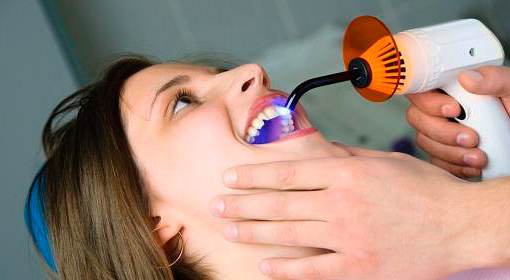
Unfortunately, each company produces composites with a set of properties that can have both positive and negative aspects. The price of such materials also varies. In any case, they are undesirable to use for subgingival deep cavities, when there is no possibility of their isolation from moisture. Such treatment for deep caries may not be effective.
Stages of deep caries treatment
The treatment of deep caries consists of a series of stages carried out by the dentist in the order required for the given clinical situation.
- Anesthesia This is an important stage of pain relief for tooth loss during the treatment phase. It allows the patient to feel comfortable and not to fear.

- Mechanical treatment of cavities from carious tissues (preparation), drug irrigation with antiseptics.
- Calcium hydroxide-based treatment pad - sometimes used in the treatment of deep caries and placed at the bottom of the carious cavity to prevent the risks of pulpitis (inflammation of the soft tissues). Its antibacterial activity has been known for a long time.
- Laying insulating gaskets. When filling with an amalgam or composite (except glass ionomer cements), isolation of the material from dentin is required in order to prevent the toxic effect of the components included in the filling composition. For laying in the treatment of deep caries, apply: zinc phosphate cements, glass ionomer cements, compomers (combine the properties of SIC and composites), etc.
- And, finally, the formulation of the seal, selected according to the characteristics of the cavity to be filled.
The following video shows an example of a treatment for deep caries:
So, in fact, the treatment of dental caries occurs (from drilling to installing a seal)
Expert Commentary
Most experts came to the conclusion that the use of a medical pad with deep caries followed by closing the cavity with a seal in one visit is an unreasonable risk for the long term. The fact is that the disappearance of a gasket based on calcium hydroxide was proved for a short time. Dentin actively absorbs the gasket with the formation of a space under the seal. This, in turn, causes shrinkage and damage to the filling, leading to infection of the tooth tissue through microcracks.
Researchers agreed that it is better to either use a medical gasket under a temporary seal, and only after a while (5-14 days) install an insulating gasket and a permanent seal without it, or not use a medical gasket even with deep caries. In most cases, this does not affect the quality of treatment in compliance with modern technologies.
Possible complications after treatment
Sometimes a person experiences quite noticeable pain after treatment of deep caries, or achs a tooth. Almost always - this is the result of certain errors on the part of the attending physician. Normally, pain should not be.
In some cases, the pain goes away within 1-2 weeks. It is called postoperative (post-filling) sensitivity, which is characterized by:
- pain with pressure on the seal;
- sensitivity from temperature stimuli (more from cold);
- discomfort.
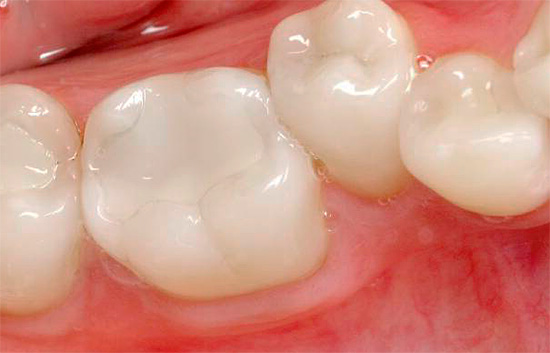
If you have a tooth ache after treating deep caries, you should definitely consult a doctor. It is especially important to immediately appear at the reception after placing the seal in the following cases:
- Acute pain (paroxysmal and spontaneous).
- Pronounced aching pains that cannot be removed even with painkillers.
- Reactions from the side of the gums near the treated tooth (edema).
- Obvious signs of overestimation of the seal and reaction to the traumatic factor. If for some reason the dentist did not completely polish a bite of the filling, which interferes with closing his teeth and chewing, then pain soon arises and a reaction to the traumatic factor develops with the subsequent occurrence traumatic pulpitis or periodontitis. There is no point in waiting for the seal to “rub”, as some patients believe, this will not happen on its own. A visit to the attending physician is required.
Such pain after treatment of deep caries often indicates its complications: pulpitis, periodontitis, periostitis, or even acute or chronic tooth trauma against the background of overestimation of the filling.
Timely assistance can not only prevent serious consequences for the tooth, but also save it after adequate treatment for life. The help that a dentist can provide at the reception for complications of deep caries:
- Replacing gaskets and seals with other options (for post-filling pains).
- Tooth treatment in canals with subsequent filling placement on the second visit.

- Correction of a seal with its overstatement, if there are no serious consequences from such an injury.
- Treatment of tooth canals and additional surgical procedures (incision, root resection, hemisection, etc.) to save all or part of the tooth in the hole using the combined method.
To summarize: if you experience pain in your tooth after treating deep caries, you don’t have to endure and wait for the consequences, it is always better to seek the advice of your doctor.
Questions to the dentist
Hello! Three days ago he was at the dentist, and he drilled my tooth so deeply that he got into the nerve, although the tooth did not hurt. I did not feel anything, since an injection was put into the gum. I ask you to answer two questions: why did the doctor decide to remove the nerve from the living tooth, but he was not sick, and also explain the reason for the short pain that occurred after treatment when chewing on the tooth, especially meat and fruit?
Alexander, Moscow
Dentist-therapist: Hello, Alexander! Unfortunately, patients often come up with problems so late that it is not possible to treat a tooth with a diagnosis of deep caries. This is due to severe tooth decay with the involvement of the "nerve" in the infectious process. Therefore, so that the tooth does not get sick under the filling, the doctor depulpates it (removes the "nerve"), and then after a certain time (less often - immediately) installs the seal. In some cases, in the first days after treatment, postoperative (post-filling) pain or sensitivity may occur due to the processing and filling of the canals.
This is due to the manipulations in the channels themselves and less often - to errors in their implementation. Usually the pain goes away within 2-5 days. If the pain lasts longer - you should consult a doctor for a consultation before the intended visit for a permanent filling. You should also contact your dentist immediately after:
- High temperature;
- Edema in the area of the tooth treated in the canals;
- Strong and unbearable pulsating pains in a filled tooth;
- Numbness in the jaw after treatment.
Price characteristics of treatment
The price of deep caries treatment depends on many factors:
- the number of visits you make to the clinic;
- materials used;
- clinic status;
- level of preparation of the doctor;
- and even the clinic’s marketing costs.
The treatment of deep caries is a complex of complex manipulations, therefore the price will also be determined by the localization of the carious cavity according to Black: for example, fillings on the front teeth are often more expensive than on the molars. This is due to the requirement of form and aesthetics. You have to use expensive materials to create an exact copy of the tooth.
Take care of your teeth and be healthy!
Interesting video: preparation of a carious cavity of class 1 according to Black
How to get rid of fear of a dentist - practical tips

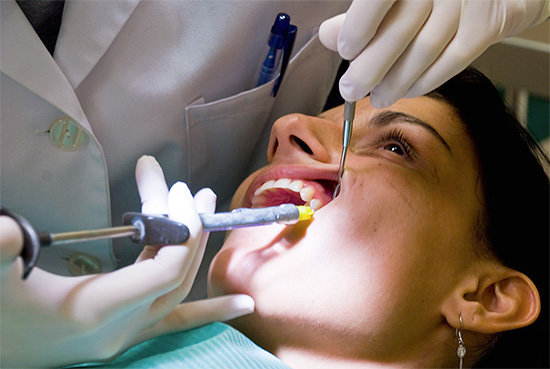
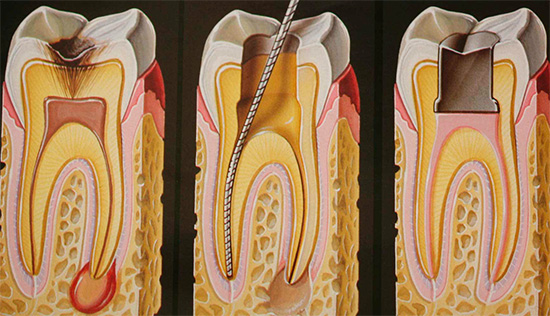
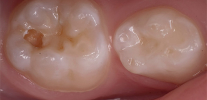
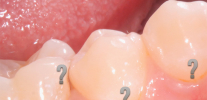
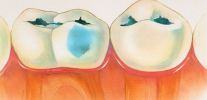
Hello! If there is severe caries on the posterior tooth, but does not hurt, and the tooth breaks off a bit from the inside, what actions will be taken during treatment by a doctor? Do not need to put a crown?
Good evening, three weeks ago I closed the 6th upper left tooth. Nerves were not removed, the hole was small and on the side, but the doctor sawed off almost half of the tooth, only the back wall and a little front remained. Within a week, the tooth did not hurt. I ate drying, and got on this tooth, after that the tooth periodically began to hurt, what could it be?
Hello! I think that we are still talking about standard post-filling pain, which was simply minimally expressed before getting hard on the tooth. It is unlikely that a displacement or damage in the form of a crack (microcrack) of the seal is possible, but it is worth checking by contacting your doctor. In principle, at the moment there is no reason not to trust your dentist (even with a visually small carious lesion when preparing a tooth, you often need to clean out significant amounts of softened tooth decay tissue). Thanks for the question.
Hello! Tell me, can a tooth react to cold and sweet if a medical gasket made of calcium is placed under the seal so as not to kill the tooth?
Hello! No, this is practically impossible. Most likely, we are talking about the fact that the causative tooth was never found. That is, next to, in the vicinity, or on the opposite jaw there is a tooth with a carious cavity, which responds to an external stimulus (cold, sweet) with short-term painful sensations.I recommend contacting a dentist and working together to find a causative tooth.
Good afternoon! A month ago, I went to the dentist, remodeled a defective filling, there was a caries under it (a completely different doctor did, and before that there was an old filling on the same tooth, and there was also caries). The hole was deep, and after treatment the tooth reacted to everything: water, fruit juice, chewing. Turned again, the doctor said that secondary dentin should form, and this usually happens within two months. The second one already passes, the tooth no longer reacts so strongly to pressing and almost does not react to water, juice, but the sensitivity to cold and hot has not completely disappeared. Tell me, is it worth remaking the seal? Since I’m not only afraid of doctors (the fourth is already treating this tooth), there are still suspicions that they didn’t put a gasket on me - they poured something, but I don’t know that. And they made a deep hole for me, but the seal itself is not completely polished, I feel rough. The color differs from the color of the tooth, darker beige.
Hello! It is possible that you were simply afraid to polish the seal because of your complaints about the previous installation of the seal with a deep, as I understand it, caries. Since the dynamics are clearly positive, judging by your description, it is not worth remaking the seal yet. You can try to fluoride the edges of the enamel near the seal. It is short-lived and inexpensive: usually 2 sessions are enough. You should abandon the whitening paste (if used) for 1-2 months, and focus on a paste containing fluorides, at least at the level of 1500 ppm, without any bleaching effect. You can add fluoride rinses as agreed with the dentist. Since I don’t see how well the seal was installed from the point of view of marginal fit, my advice is about post-filling sensitivity and (possibly) slightly excessive grinding of the tooth walls near the filling with boron when its height was adjusted by bite.
As for the “deep fossa”: with a high probability we can say - there is no fault of the doctor that there were so many carious tissues that had to be excised in order to avoid relapse of caries or even its complication - pulpitis.
Good evening, Svyatoslav Gennadievich! This is Elena, I wrote to you. I am currently in Moscow, and I brought the tooth picture with me. If you can consult or somehow contact you, share your contacts, if possible. Happy New Year! Thanks.
Hello! I do not live in Moscow, but I can fully advise on a tooth picture - you can send it to the site’s mail, and after a while I will describe everything as it is (without embellishment, as doctors sometimes do in clinics).
Hello, today I treated two teeth with deep caries at a doctor. After the anesthesia was gone, all the teeth that got under anesthesia began to whine. I called dentistry, the doctor said that this was because they did not kill the nerve, said something about secondary dentin and that the pain should go away after 3-5 days. I suggested coming tomorrow to a physio laser, for free, in just a few minutes.
They put a medicinal pad under the seals, I don’t know which one.
Can you somehow comment on whether I should worry, or is this normal? The pain is quite strong, but bearable, gives to the temple, to the front two teeth of the upper, although only the two lower, farthest were treated.
Hello! With pain in the lower teeth, the pain can radiate to the temple and upper teeth - this is quite normal from the point of view of innervation.If your pain is spontaneous and lasts for a long time, aggravated by other irritants, then, unfortunately, it is very likely that some of the two teeth will have to be depulped. The biggest difficulty: decide which tooth has a pulp problem in response to treatment. And was there deep caries in it at all - maybe there were signs of a beginning or chronic pulpitis? He just does not have pronounced symptoms - the doctor could have missed this moment.
Now a few words in case the pains still do not go away (that is, if pulpitis is confirmed). If the dentist insists on the removal of both teeth, then you should get help in the clinic where there is EDI. In many cases, it is otherwise difficult to find out which tooth hurts: well, unless the stage of the inflammatory process inside the canal reaches the shape where it is possible to precisely point to the tooth, or the doctor can "feel" for something using the method of instrumental examination. Electroodontodiagnosis (EDI) is not done in all clinics, but both teeth are depulpated so as not to guess on the “camomile” - blasphemy.
Hello, Svyatoslav Gennadievich! Yesterday I treated the top five for deep caries, the tooth was not depulped. Now it hurts to press a tooth. This is normal? Or should I see a doctor?
Hello! This can be a standard post-filling pain, or damage or infection of the pulp. The first option can be quite harmless - as a rule, the pain decreases every day. However, there is no exact time frame when the pain should completely pass: a number of doctors believe that it is advisable to wait no more than 2-3 weeks, while the symptoms decrease and new ones do not appear (severe pains, throbbing, from hot, cold, nightly, etc. .d.).
If the clinic has EDI, then you should contact now, otherwise you can check whether the doctor made mistakes or not by observing the treated tooth. If from 3-4 days it becomes easier to press the tooth, then it is quite possible to wait for some time and observe. If pain symptoms increase, run to the doctor.
Hello, Stanislav Gennadievich. Today I changed the filling, returning home, I found that now the dental floss does not pass. I called my doctor, she said that it was thought that it was necessary that she made such contact, was very convincing. I don’t even know how many times I heard and read that this should not be. An experienced doctor (the head doctor of the clinic), before that there were no problems, her fillings stood for more than 12 years, one still as new. And I don’t know what to think. Trust the doctor and stop worrying, or still insist on over-filling (which I do not want to do). What do you advise? Thanks.
Hello! In terms of standards, this work is not considered high quality. The thread should be inserted into the interdental space with little effort. The absence of a gap is not the norm, although not in all cases such "dense" fillings are a big problem. Rather, such fillings pose a danger in the future due to subsidence on the gingival papilla. Often during chewing, sooner or later, spontaneous “wedging” of teeth may occur, and a gap will appear, and the benefit of such a moment for the future will be doubtful.
After restoration of the lateral surface of the tooth, it should be perfectly smooth, have a shape characteristic of this tooth with the possibility of adequate hygiene without injuring the gingival gap. From the point of view of the doctor’s work, I can say that sometimes it’s difficult to recreate such a gap that meets all the quality criteria. That is, sometimes this contact point for a number of reasons can be recreated, according to the protocol, only in an orthopedic way: tab, crown, etc.There is also a combined method of manufacturing an impression and applying a photopolymer to the prepared cavity using special matrices that exclude possible problems with poor interdental space.
Before insisting on a refill, it is important to know whether it is possible to do it at all with a given doctor in a different way. It is possible that you will need to change the doctor and clinic.
Today she was treating a tooth, the doctor thought that I had pulpitis, but there was superficial caries. During treatment, the tooth began to periodically hurt (anesthetized three times). When the anesthesia passed, the tooth continues to just hurt for no reason: not much, but unpleasant. Should I run back to the doctor?
Hello! If during the treatment anesthesia acted poorly, this means that with a high probability the doctor either does not know the techniques of high-quality anesthesia or does not have an imported anesthetic available. As for post-filling pains, the reason for them may be very different. If during treatment there were no serious complications, then such pains pass without a trace usually in 3-10 days. If you wish, you can send a tooth picture to the site’s mail - I will comment in more detail.
Hello! Is it necessary to remove wisdom teeth?
Hello! Not at all necessary, but often it is necessary to do this according to certain indications. The fact is that the wisdom teeth in many people (usually women) do not fit in the jaw when teething, therefore they either erupt “crookedly” or cannot erupt at all, which causes severe pain, inflammation, up to osteomyelitis. It is not worthwhile to remove wisdom teeth that are normally oriented in the jaw in a preventive order (for prevention), since when they are correctly erupted, they often participate in chewing and even (periodically) come in handy in a difficult situation for fixed prosthetics (bridges, for example). That is, wisdom teeth are removed only if they threaten human health or interfere with orthodontic or orthopedic treatment. In other cases, it is advisable to try to save them.
Hello. More than a month ago, I was treated for deep caries (in one visit) in different places, and it still hurts to press on both teeth. Today I called, and the doctor said - probably there is a nerve close, we will do an x-ray. If so, you will have to remove the nerve.
Is it justifiable to kill a healthy nerve (without pulpitis) due to the proximity of the seal? I read about such pain - that it’s not enough or the tooth is too dry. Is it possible then another way out, and not removal of the nerve? And is the doctor now obliged to fix the problem for free if he gave a guarantee for a year?
Due to improper installation of the seal, caries formed under it. The doctor suggests removing the tooth and immediately begin preparing for implantation. Are there any other options? Will it be possible to remove the tooth now, and then put the implant in a year?
Hello Anastasia. And why does the doctor immediately suggest removing the tooth? If there is only caries under the filling, then it can be eliminated and a new filling, or tab, or crown, depending on the degree of damage to the tooth.
As for tooth extraction and subsequent implantation - it is better to do this simultaneously, if the condition of the bone tissue allows (thickness and height of the crest). Or delayed, 4-6 months after removal. If you walk without a tooth for a long time, then bone tissue atrophy and tooth displacement towards the defect occur (Popov-Godon syndrome).
Good evening! 4 days ago they treated 6 with deep caries. They did everything without anesthesia, tapped - everything is fine. I came home, began to whine a little.The doctor said that there could be such a reaction to the material that she laid. She advised me to drink antihistamines a couple of days and Nimesil. Aching pain has passed. Now it reacts when biting ... Is this the norm? Could this be? And yes, it’s kind of like, it reacts to sweets. And sometimes it twitches a little there ...
Hello! Post-filling pain is not so rare in patients, especially after treatment of deep caries. It is necessary to observe, and with an increase in pain, take an x-ray to clarify the causes of pain. The tooth may bother for a month, but the pain should gradually decrease. If, on the contrary, it intensifies, the tooth reacts to cold and hot - this means that, most likely, it will be necessary to remove the tooth (remove the "nerve").